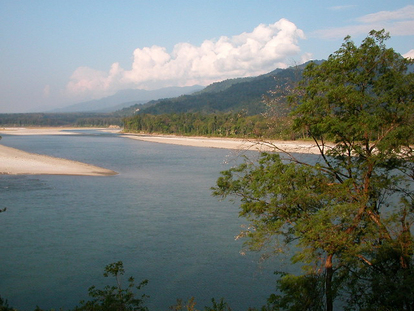What plays into this ecosystem?
Abiotic Factors
The Manas River runs completely through Manas National Park. This offers energy for running buildings within the park, but also drinking water for the animals, and more diversified habitat within the park, and a transportation method for tourists within the park. During times of drought, water levels drop, leaving little water for organisms. Meanwhile, during times of heavy rainfall, water is able to come up over the banks and flood flat lands.
The amount of sunlight Manas National Park receives is also another important abiotic factor. Heavy rainfall occurs in the summer months between May and September, which sometimes cuts off needed sunlight. Without this energy, plants might not survive from the lack of ability to go through photosynthesis, and animals would have the potential to starve.
The amount of sunlight Manas National Park receives is also another important abiotic factor. Heavy rainfall occurs in the summer months between May and September, which sometimes cuts off needed sunlight. Without this energy, plants might not survive from the lack of ability to go through photosynthesis, and animals would have the potential to starve.
Biotic Factors
Within biotic factors, Manas National Park and its organisms are affected by predation and parasitism. Predation keeps larger, primary consumer populations under control, so the ecosystem is able to maintain balance with its resources, such as the balance between Indian Hares and Leopards.
Meanwhile, parasitism can be considered a major problem for Manas and any other park around that area. With such a (usually) moist enviornment, bugs such as mosquitoes are abundant, which can carry parasites that can cause malaria and other deadly diseases.
Meanwhile, parasitism can be considered a major problem for Manas and any other park around that area. With such a (usually) moist enviornment, bugs such as mosquitoes are abundant, which can carry parasites that can cause malaria and other deadly diseases.
Limiting Factors
In Manas National Park, there are factors that limit the size of the population. The first type is called density-independent, which include droughts, fires, flooding, and heavy storms. These factors happen regardless of population size in an ecosystem. Meanwhile, density-dependent factors, such as starvation from a lack of food (one of the reasons the pygmy hog became endangered), competition to occupy a certain space, and lack of predation, also play a role in Manas.
Succession- Primary and Secondary
Primary succession in the area of Manas National Park would probably have been due to a glacier moving through the space. All that would be left once the glacier did pass would be grasses and shrubbery that could survive on the soil. As time went on, more plants would grow and prosper, creating areas with rainforests, such as in Manas's temperate rainforest ecosystem, and areas of large grasslands and sparse trees, such as a grassland. Once the land was sustainable, smaller animals would start to occupy the lands, which would be followed by secondary consumers.
Meanwhile, secondary succession would be due to a large fire/natural disaster or humans abandoning the area. In a grassland, this would probably be due to a drought fire, which destroys the land around it. In a rainforest, it would be due to human disturbance in cutting down trees and leaving without replanting. Both these areas would grow back more quickly, because seeds of different plants are still available in the soil, and the soil is more rich in minerals to provide nourishment in growth. However, most animals would be killed or run out of the habitat that was being destroyed, and might not be as quick to return.
Meanwhile, secondary succession would be due to a large fire/natural disaster or humans abandoning the area. In a grassland, this would probably be due to a drought fire, which destroys the land around it. In a rainforest, it would be due to human disturbance in cutting down trees and leaving without replanting. Both these areas would grow back more quickly, because seeds of different plants are still available in the soil, and the soil is more rich in minerals to provide nourishment in growth. However, most animals would be killed or run out of the habitat that was being destroyed, and might not be as quick to return.

